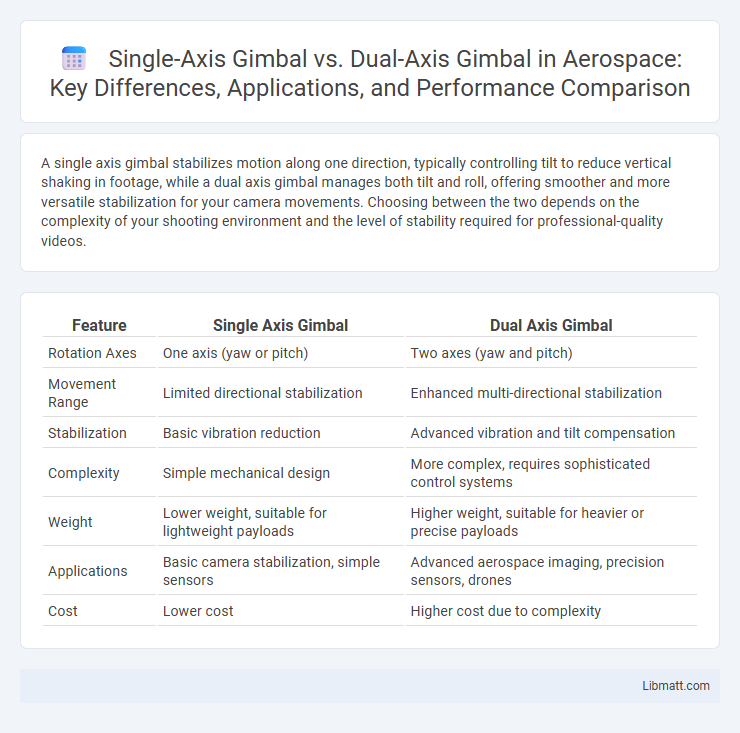A single axis gimbal stabilizes motion along one direction, typically controlling tilt to reduce vertical shaking in footage, while a dual axis gimbal manages both tilt and roll, offering smoother and more versatile stabilization for your camera movements. Choosing between the two depends on the complexity of your shooting environment and the level of stability required for professional-quality videos.
Table of Comparison
| Feature | Single Axis Gimbal | Dual Axis Gimbal |
|---|---|---|
| Rotation Axes | One axis (yaw or pitch) | Two axes (yaw and pitch) |
| Movement Range | Limited directional stabilization | Enhanced multi-directional stabilization |
| Stabilization | Basic vibration reduction | Advanced vibration and tilt compensation |
| Complexity | Simple mechanical design | More complex, requires sophisticated control systems |
| Weight | Lower weight, suitable for lightweight payloads | Higher weight, suitable for heavier or precise payloads |
| Applications | Basic camera stabilization, simple sensors | Advanced aerospace imaging, precision sensors, drones |
| Cost | Lower cost | Higher cost due to complexity |
Introduction to Gimbals: Single Axis vs Dual Axis
Single axis gimbals stabilize camera movement along one axis, typically the tilt, providing basic balance and reducing vertical shake for smoother footage. Dual axis gimbals offer stabilization on two axes, usually tilt and roll, enhancing control and delivering steadier shots by minimizing horizontal and vertical vibrations. Choosing between single and dual axis gimbals depends on the required level of stability and the complexity of the motion during filming.
How Single Axis Gimbals Work
Single axis gimbals stabilize motion by controlling rotation along a single axis, typically the pitch, to counteract unwanted tilting or shaking. These gimbals use a motor and sensor system to detect and correct angular displacement, ensuring smoother footage or precise instrument positioning. If your application requires basic stabilization, a single axis gimbal offers a simpler, lighter, and more cost-effective solution compared to dual axis gimbals.
The Technology Behind Dual Axis Gimbals
Dual axis gimbals utilize advanced brushless motors and MEMS sensors to stabilize camera movement along two rotational axes, significantly reducing unwanted pitch and roll vibrations. This technology employs real-time motion tracking and rapid motor adjustments to maintain smooth, steady footage even during brisk movements or uneven terrain. Compared to single axis gimbals, dual axis systems offer enhanced stabilization performance, resulting in clearer and more professional-quality video output.
Key Differences Between Single and Dual Axis Gimbals
Single axis gimbals stabilize motion around one rotational axis, typically controlling tilt, making them ideal for simple filming or photography where limited movement compensation is needed. Dual axis gimbals offer stabilization across two axes, usually tilt and roll, providing smoother footage in dynamic environments by correcting more complex motion disturbances. The added axis in dual axis gimbals enhances stability and versatility but often results in increased weight and higher cost compared to single axis models.
Advantages of Single Axis Gimbals
Single axis gimbals offer simplified control and reduced weight, making them ideal for lightweight cameras and drones where minimal stabilization is needed. They provide effective tilt stabilization, enhancing video smoothness without the complexity or power consumption of dual axis systems. This makes single axis gimbals cost-effective and easy to maintain in applications that do not require full 3D stabilization.
Benefits of Dual Axis Gimbals
Dual axis gimbals provide enhanced stabilization by compensating for both pitch and roll movements, resulting in smoother and more professional footage compared to single axis gimbals that only stabilize one axis. This improved control makes dual axis gimbals ideal for handheld cameras, drones, and action cameras, reducing shaky video and motion blur significantly. Their ability to maintain horizon level during dynamic movements benefits aerial videography and fast-paced filming environments.
Application Areas: Choosing the Right Gimbal
Single axis gimbals excel in stabilizing pitch movements, making them ideal for applications like handheld cameras or drones primarily needing smooth forward and backward tilts. Dual axis gimbals provide enhanced stabilization by controlling both pitch and roll, crucial for dynamic shooting scenarios such as action sports, aerial photography, or any situation involving complex motion. Understanding your filming environment and motion requirements helps you choose the right gimbal to ensure your footage remains steady and professional.
Performance Comparison: Stability and Motion Control
Single axis gimbals provide basic stabilization by controlling tilt, ideal for smooth vertical motion, while dual axis gimbals enhance performance by stabilizing both tilt and roll axes, resulting in more precise motion control and greater stability during dynamic shooting conditions. Dual axis gimbals reduce vibrations and unwanted angular movements more effectively, offering superior image clarity and smoother video footage compared to single axis systems. For applications requiring high stability and complex motion management, dual axis gimbals outperform single axis models in maintaining steady shots under accelerated or uneven movements.
Price and Accessibility: Single vs Dual Axis Options
Single-axis gimbals generally offer a more affordable and accessible solution for beginners or budget-conscious users, with prices typically ranging from $50 to $200. Dual-axis gimbals, while pricier--usually between $150 and $400--provide enhanced stability by controlling both tilt and roll, making them favored by professional videographers. The choice between single and dual-axis gimbals largely depends on the required level of motion control and budget constraints.
Which Gimbal Should You Choose?
A single axis gimbal stabilizes movement along one plane, ideal for simple filming scenarios with minimal motion. Dual axis gimbals offer enhanced stabilization by controlling two planes, making them suitable for more dynamic shots and professional-level videography. Your choice depends on the complexity of your movements and desired smoothness in footage.
single axis gimbal vs dual axis gimbal Infographic

 libmatt.com
libmatt.com